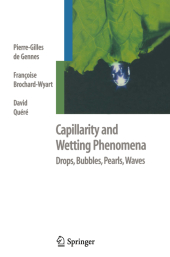 Neuerscheinungen 2010Stand: 2020-01-07 |
Schnellsuche
ISBN/Stichwort/Autor
|
Herderstraße 10
10625 Berlin
Tel.: 030 315 714 16
Fax 030 315 714 14
info@buchspektrum.de |

Francoise Brochard-Wyart, Pierre-Gilles de Gennes, David Quere
(Beteiligte)
Capillarity and Wetting Phenomena
Drops, Bubbles, Pearls, Waves
Softcover reprint of the original 1st ed. 2004. 2010. xvi, 292 S. 7 Tabellen. 235 mm
Verlag/Jahr: SPRINGER, BERLIN 2010
ISBN: 1-441-91833-7 (1441918337)
Neue ISBN: 978-1-441-91833-8 (9781441918338)
Preis und Lieferzeit: Bitte klicken
The study of capillarity is in the midst of a veritable explosion. Hence the temptation to write a new book, aiming at an audience of students. What is offered here is not a comprehensive review of the latest research but rather a compendium of principles.
How does one turn a hydrophilic surface into one that is hydrophobic, and vice versa? We will describe a few solutions. Some rely on chemical treatments, such as coating a surface with a molecular layer. Others are based on physics, for instance by controlling the roughness of a surface. We will also examine the dynamics of wetting. Drops that spread spontaneously do so at a rate that slows down with time. They can be tricked into covering large areas by spreading them suddenly. We will describe a few of the many facets of their dynamical properties.
Special additives are required for water to foam. Foams are desirable in a shampoo but can be a nightmare in a dishwasher detergent. Antifoam agents have been developed and are well known, but how do they work? It is also possible to generate bubbles and foams without special additives, for example in pure and viscous liquids such as glycerin, molten glass, and polymers. As we will see, the laws of draining and bursting then turn out to be quite different from the conventional ones.
This book will enable the reader to understand in simple terms such questions that affect every day life -- questions that also come up during in industry. The aim is to view systems that often prove quite complex in a way that isolates a particular physical phenomenon, often avoiding descriptions requiring advanced numerical techniques will oftentimes in favor of qualitative arguments. This strategy may at times jeopardize scientific rigor, but it makes it possible to grasp things efficiently and to invent novel situations.
Capillarity: Unconstrained Interfaces / Capillarity and Gravity / Hysteresis and Elasticity of Triple Lines / Wetting and Long-Range Forces b/ Hydrodynamics of Interfaces -- Thin Films, Waves, and Ripples / Dynamics of the Triple Line / Dewetting / Surfactants / Special Interfaces / Transport Phenomena


